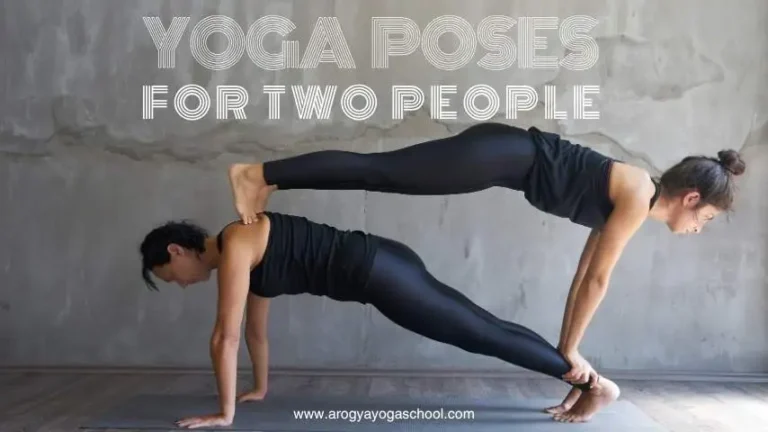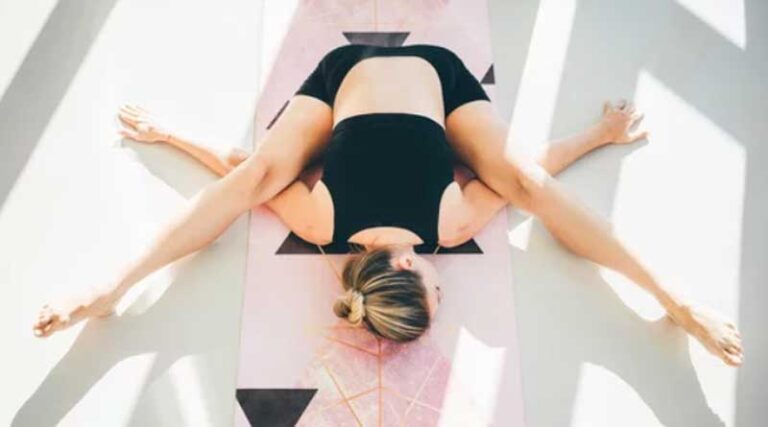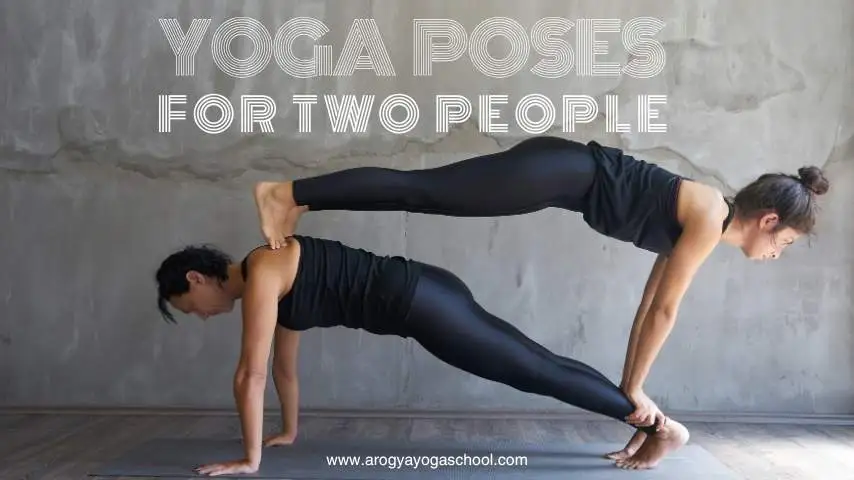
Yoga is often seen as a solo practice—quiet, inward, and deeply personal. But people can also share yoga.
Partner yoga, or yoga poses for two people, blends physical postures with communication, balance, trust, and playful connection. When you practice with a friend, partner, or family member, these poses can help. They deepen stretches, strengthen muscles, and improve mindfulness through teamwork.
This guide will show you the benefits of partner yoga. It includes safety tips and clear instructions for ten effective poses for two people. These poses are suitable for beginners to intermediates.
Why Practice Yoga Poses for Two People (Partner Yoga)
Practicing yoga with someone else adds unique layers to your experience:
1. Enhanced Stretch and Alignment
A partner can help you safely deepen stretches, improve posture, and correct alignment. Many people find they can access positions with a partner that they could not comfortably reach alone.
2. Increased Trust and Communication
Partner yoga includes both talking and silent communication. Matching your breath, movements, and goals strengthens emotional ties and connections.
3. Balance and Body Awareness
Two-person yoga poses demand balance and stability. You become more aware of your center of gravity and how weight shifts between two bodies.
4. Playfulness and Enjoyment
Practicing with another person often feels lighter and more fun. Laughter, play, and experimentation become part of the yoga experience.
5. Emotional Connection
Couples often use partner yoga as a bonding activity. Some poses invite closeness, eye contact, and synchronized breathing, making it both physically and emotionally grounding.
Safety Tips Before You Begin – Yoga Poses for Two People
Partner yoga is available to many people, but safety must always come first.
- Communicate clearly. Use phrases like “a little deeper,” “hold there,” or “that’s enough.”
- Move slowly. Don’t jump into deep stretches; warm up first.
- Match skill levels. If one partner is more flexible or stronger, adjust to the partner with less experience.
- Avoid pain. Discomfort is okay—sharp pain is not.
- Choose a stable surface. A non-slip mat or padded floor is ideal.
- Stay mindful of injuries. Avoid poses that strain the neck, lower back, or knees if either partner has limitations.
11 Yoga Poses for Two People
Below are 11 Yoga Poses for Two People (partner yoga poses) that range from relaxing and gentle to playful and challenging. Each includes step-by-step instructions and benefits.
1. Seated Back-to-Back Breath (Beginner)
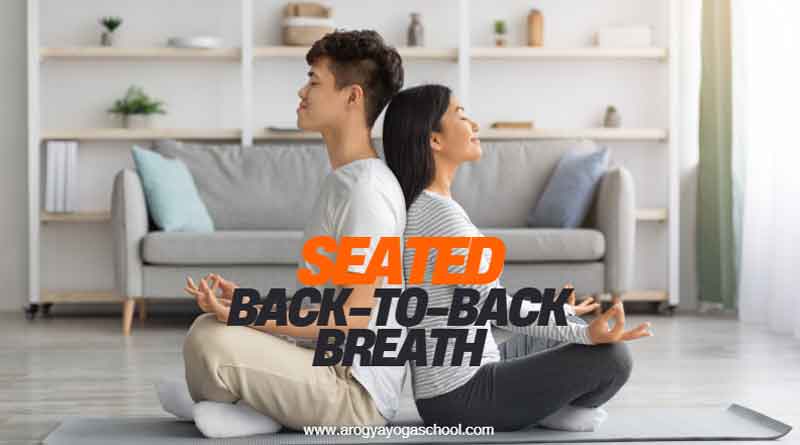
How to Do It
- Sit cross-legged, back-to-back with your partner.
- Lengthen your spines and relax your shoulders.
- Place your hands on your knees or thighs.
- Close your eyes and begin to synchronize your breathing.
- Inhale deeply for four seconds, hold for two, and exhale for four.
Benefits
- Builds harmony and connection.
- Encourages proper posture.
- Helps partners tune into each other’s rhythm.
This pose is a great warm-up. It helps you focus your mind before doing more physical poses.
2. Partner Seated Twist (Beginner)
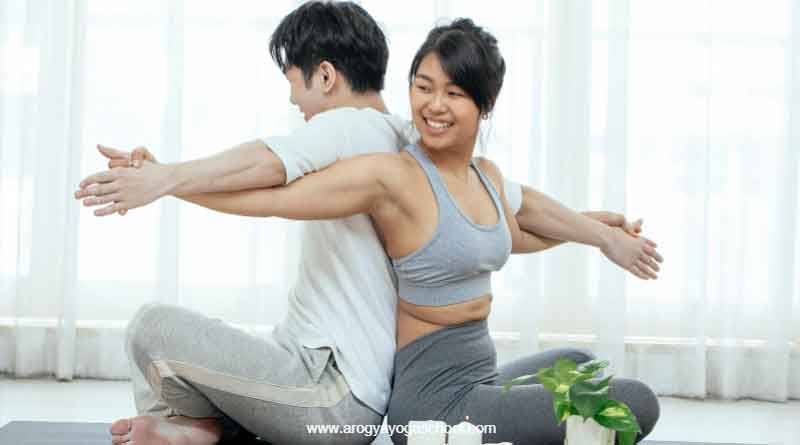
How to Do It
- Sit back-to-back with legs crossed.
- Inhale and lengthen your spine.
- Twist to the right; reach your left hand to your right knee.
- Reach your right hand behind to meet your partner’s left hand.
- Hold for five breaths and switch sides.
Benefits
- Stretches the spine and obliques.
- Improves posture and flexibility.
- Encourages coordinated breathing and movement.
3. Double Forward Fold (Beginner)
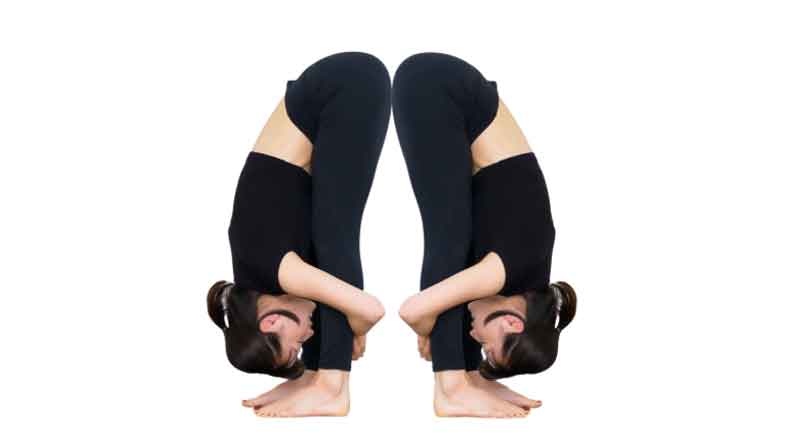
How to Do It
- Sit facing each other with your legs extended and feet touching.
- Hold each other’s wrists or hands.
- One partner slowly leans back, gently pulling the other into a forward fold.
- After 20–30 seconds, switch roles.
Benefits
- Deepens hamstring and lower-back flexibility.
- Introduces gentle trust between partners.
- This makes you feel supported while you stretch.
4. Twin Tree Pose (Beginner–Intermediate)
How to Do It
- Stand side by side with hips touching.
- Each partner lifts the outer foot and places it on the inner thigh or calf of the standing leg.
- Reach the inner arms around each other’s backs.
- Raise the outer arms overhead and touch palms.
Benefits
- Strengthens legs and core.
- Improves balance with shared support.
- Builds trust, stability, and concentration.
This pose is often hilarious at first—wobbling is part of the experience.
5. Double Downward Dog (Beginner–Intermediate)

How to Do It
- Partner A enters a classic downward dog.
- Partner B stands behind and places hands on Partner A’s ankles.
- Partner B places one foot at a time on Partner A’s lower back or hip. They walk their feet up into a mini downward dog position.
- Hold for 5–8 breaths, then switch.
Benefits
- Gently compresses and stretches the spine.
- Strengthens arms and shoulders.
- Deepens both partners’ hamstring flexibility.
Be sure to communicate about pressure—this pose should never cause strain.
6. Partner Boat Pose (Intermediate)
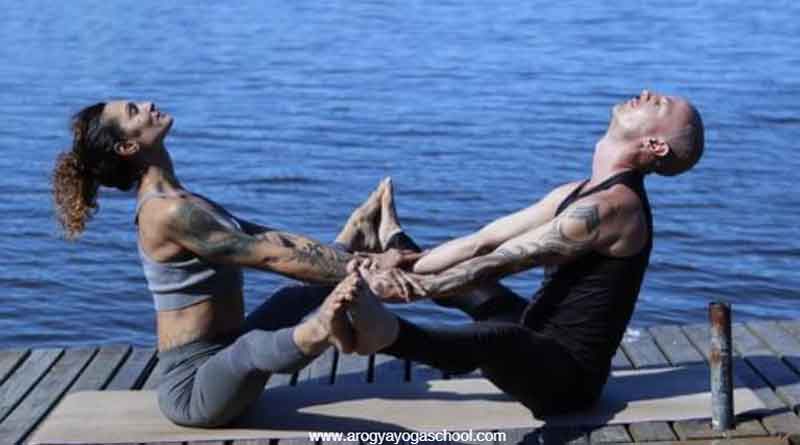
How to Do It
- Sit facing each other, knees bent, toes touching.
- Hold hands and bring the soles of your feet together.
- Lift your feet until your legs form a “V” shape.
- Straighten your legs if possible and hold for 5–10 breaths.
Benefits
- Strengthens the core and hip flexors.
- Improves balance and coordination.
- Promotes steady breathing while using your muscles.
7. Chair Pose for Two (Intermediate)

How to Do It
- Stand back-to-back with feet hip-width apart.
- Slowly walk your feet forward as you lower into a seated position.
- Keep your backs pressed firmly together and hold for 10–20 seconds.
Benefits
- Strengthens quads, glutes, and core.
- Enhances trust and alignment.
- Builds heat quickly—great for warming up.
8. Supported Backbend (Intermediate)
How to Do It
- Stand facing each other, feet hip-width apart.
- Grasp forearms or hands firmly.
- Each partner gently leans back, maintaining a strong grip.
- Let the chest open and shoulder blades draw together.
Benefits
- Stretches shoulders and chest.
- Strengthens legs and back muscles.
- Builds trust through mutual support.
9. Flying Angel (Acro Yoga – Intermediate/Advanced)
How to Do It
- Partner A (the “base”) lies on their back with knees bent.
- Partner B (the “flyer”) stands at Partner A’s feet.
- Base places feet at the flyer’s hip bones for support.
- Holding hands, the flyer leans forward as the base lifts their legs, raising the flyer off the ground.
- Slowly straighten legs until the flyer is horizontal, balancing like a “flying angel.”
Benefits
- Strengthens core and stabilizer muscles.
- Enhances coordination, trust, and focus.
- Creates a sense of play and accomplishment.
This is one of the most iconic partner yoga poses—stable communication is essential.
10. Partner Savasana (All Levels)
How to Do It
- Lie on your backs side by side.
- Close your eyes and relax your muscles.
- Place your hands lightly on each other’s palms or stomachs.
- Breathe slowly for 2–5 minutes.
11. Two-Person Plank Pose
The plank pose for two people is a fun partner yoga exercise. It strengthens the core, arms, shoulders, and legs. This pose also helps build coordination and trust between partners.
You can perform it in a beginner-friendly version or a more advanced stacked variation. Both forms encourage stability, communication, and synchronized breathing.
How to Do the Basic Two-Person Plank
This version is ideal for beginners or those warming up.
Steps
- Partner A begins in a traditional high plank: wrists under shoulders, legs extended, core tight, and spine neutral.
- Partner B kneels behind Partner A and places their hands on Partner A’s hips or upper back.
- Partner B extends their legs back into a plank position, aligning their shoulders over their wrists.
- Both partners maintain strong, active cores, pressing heels back and engaging the thighs.
- Hold for 20–30 seconds, or longer if comfortable, keeping breath smooth and even.
Benefits
- Deep mental and physical relaxation.
- Helps integrate the whole practice.
- Promotes connection through stillness.
How to Structure a session Yoga Poses for Two People
Here’s a simple structure you can use for a 20–30-minute partner yoga sequence:
1. Warm-Up (2–3 minutes)
- Back-to-back breathing
- Gentle twists
2. Stretching (5 minutes)
- Double Forward Fold
- Seated Side Stretch
3. Standing Poses (8–10 minutes)
- Twin Tree Pose
- Partner Chair Pose
- Supported Backbend
4. Balancing/Acro Poses (5–8 minutes)
- Partner Boat
- Flying Angel (optional)
5. Cool-Down (2–3 minutes)
- Gentle seated stretches
- Partner Savasana
This flow creates a balanced mix of movement, strength, flexibility, and quiet reflection.
Tips for Making Partner Yoga (Yoga Poses for Two People) Enjoyable
1. Start with Easy Poses
You don’t need to start with advanced acro yoga. Beginners often gain the most from simple supported stretches.
2. Use Consistent Cues
Short, clear communication works best:
- “Pull more”
- “Gentle pressure”
- “Hold”
- “That’s enough”
3. Respect Boundaries
Yoga should never feel forced. Move only within your comfortable range.
4. Laugh!
Wobbling, tipping, and falling (carefully) are part of partner yoga. A playful attitude improves the experience.
5. Create the Right Space
Soft lighting, calm music, and a clean mat can help deepen the sense of connection.
Final Thoughts Yoga Poses for Two People
yoga poses 2 people offer a fun way to improve your practice. Partner yoga can help you get more flexible, build strength, and strengthen your emotional connections. It offers benefits for everyone. – You can start with simple breathing exercises.
– Then, try fun acro poses like the Flying Angel.
– This shared experience helps build trust.
– It also improves communication and balance. These benefits are hard to achieve alone.
Try some of the Yoga Poses for Two People above. Experiment with what feels good. Remember, connection—not perfection—is the heart of partner yoga.





